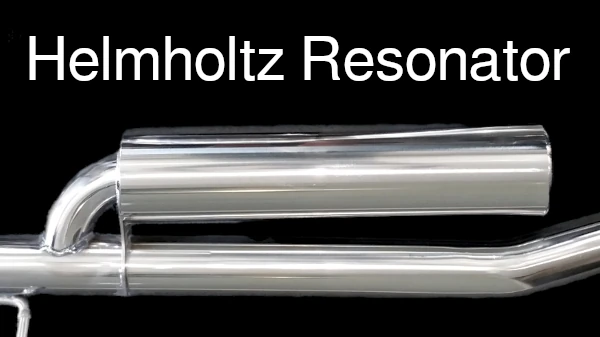Unveiling the Power of Helmholtz Resonators in Exhaust Systems
In the intricate world of automotive engineering, where every component plays a vital role in optimizing performance and efficiency, the quest for innovation never ceases. One remarkable component that has found a crucial place in exhaust systems is the Helmholtz resonator. This deceptively simple device, named after German physicist Hermann von Helmholtz, possesses the remarkable ability to manipulate sound waves and enhance the functionality of exhaust systems. To fully appreciate the power of Helmholtz resonators, let's delve deeper into their scientific principles and their impact on automotive design.
Understanding Helmholtz Resonators:
A Helmholtz resonator is essentially an acoustic resonator, consisting of a cavity, a connecting neck, and an opening. The size of the cavity and the length and diameter of the neck are carefully calculated to target and attenuate specific frequencies of sound. When sound waves enter the resonator, they cause the air inside the cavity to vibrate, creating an oscillating pressure. This oscillation, when tuned to the desired frequency, effectively cancels out the corresponding frequency in the incoming sound, resulting in a reduction in noise.
The Science of Noise Reduction:
Internal combustion engines produce a cacophony of sound frequencies during operation, and not all of them are desirable. While some frequencies contribute to the distinctive engine roar, others, particularly in the lower range, can manifest as an unpleasant drone that permeates the vehicle cabin. This drone, caused by the resonance of the exhaust system itself, can be particularly bothersome during certain driving conditions, such as cruising at highway speeds.
Helmholtz resonators act as acoustic filters, absorbing and canceling out specific frequencies associated with the engine's operation. This selective absorption is achieved through the resonance phenomenon, where the natural frequency of the resonator corresponds to the unwanted frequency in the exhaust noise. When the resonator is tuned to the target frequency, the air inside the cavity vibrates in sympathy with the incoming sound wave, effectively absorbing its energy and reducing its intensity.
Applications in Automotive Engineering:
The integration of Helmholtz resonators into exhaust systems has become a common practice in automotive engineering. These resonators effectively address the issue of "exhaust drone," enhancing the overall driving experience. By strategically placing resonators in the exhaust system, engineers can tailor the system to reduce specific frequencies, without compromising the desirable engine roar. This precise tuning ensures that the exhaust system produces a pleasing sound profile, free from intrusive drone.
Optimizing Engine Performance:
Beyond noise reduction, Helmholtz resonators contribute to optimizing engine performance. The elimination of certain frequencies in the exhaust allows for better tuning of the engine, potentially improving horsepower and torque. This fine-tuning is particularly crucial in the design of high-performance vehicles where every aspect of the engine's operation is carefully calibrated.
By reducing backpressure in the exhaust system, Helmholtz resonators can help the engine breathe more freely, allowing for a more efficient combustion process. This improved efficiency can lead to gains in horsepower and torque, particularly at higher engine speeds.
Challenges and Engineering Solutions:
While Helmholtz resonators offer significant benefits, their integration into exhaust systems comes with engineering challenges. The design process involves a delicate balance between the dimensions of the resonator and the characteristics of the engine's exhaust noise. Engineers must consider factors such as temperature variations, pressure changes, and the dynamic nature of the exhaust system to ensure the resonators operate effectively under diverse conditions.
One challenge is the harsh environment in which exhaust systems operate. The resonators must be able to withstand high temperatures, vibrations, and corrosive exhaust gases. Engineers carefully select materials and design geometries that can endure these demanding conditions.
Advancements in Exhaust Technology:
As automotive technology advances, so does the application of Helmholtz resonators. Engineers are continually refining their designs, exploring new materials, and employing computational simulations to enhance the performance of exhaust systems. The goal is not only to meet noise regulations but also to improve fuel efficiency, reduce emissions, and provide a more refined driving experience.
One area of advancement is the use of active Helmholtz resonators. These resonators incorporate electronically controlled valves that can dynamically adjust the resonator's frequency response. This allows for real-time noise cancellation, adapting to changing engine operating conditions and providing even more effective drone reduction.
Conclusion:
In the symphony of automotive engineering, Helmholtz resonators play a crucial role as silent maestros, orchestrating the reduction of unwanted frequencies in exhaust noise. Their ability to selectively attenuate specific sound waves has made them indispensable components in modern exhaust systems. As technology continues to evolve, the application of Helmholtz resonators will undoubtedly play an even greater role in shaping the future of automotive exhaust systems, ensuring a quieter, more efficient, and environmentally friendly driving experience.
Helmholtz resonators, with their remarkable ability to manipulate sound waves, have transformed the landscape of automotive exhaust systems. Their impact extends beyond mere noise reduction, contributing to improved engine performance, fuel efficiency, and overall vehicle refinement. As engineers continue to refine resonator designs and explore innovative applications, the future of automotive exhaust systems promises to be even more harmonious and sustainable. The silent maestros of automotive acoustics, Helmholtz resonators, will undoubtedly continue to play a pivotal role in this symphony of innovation.
